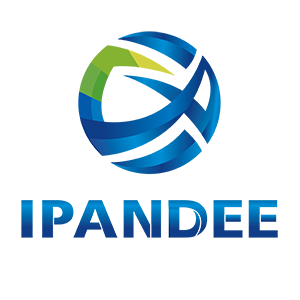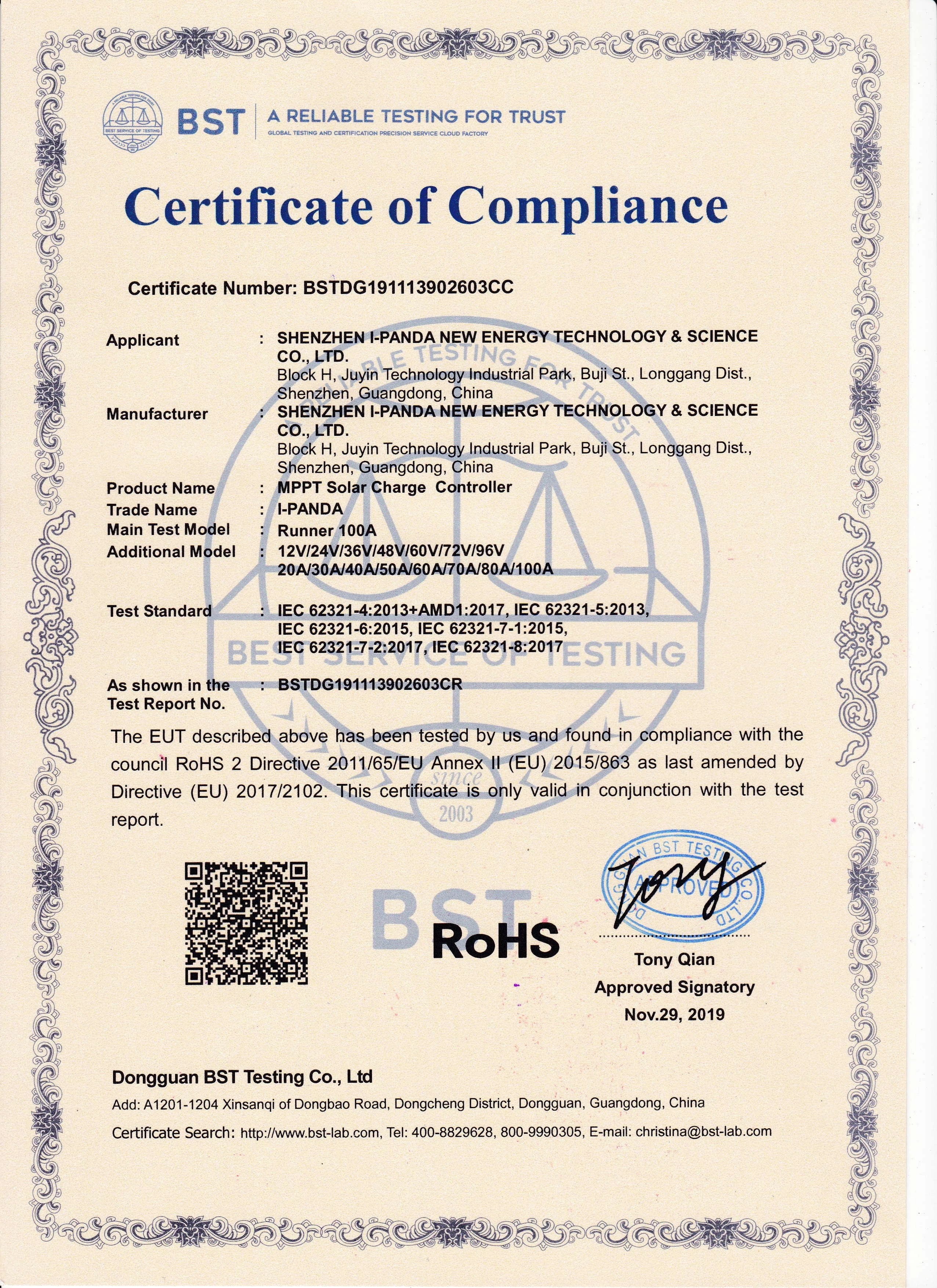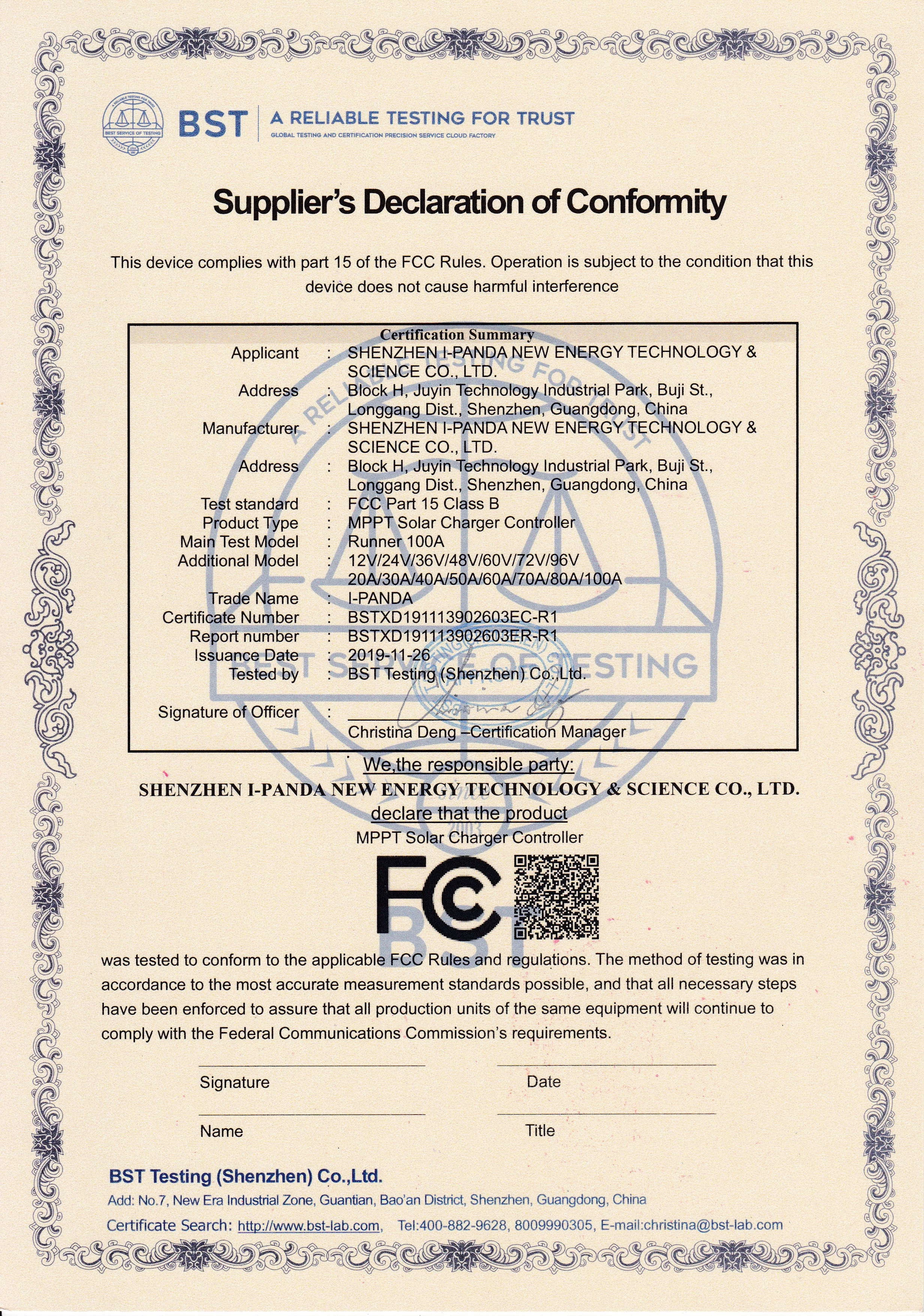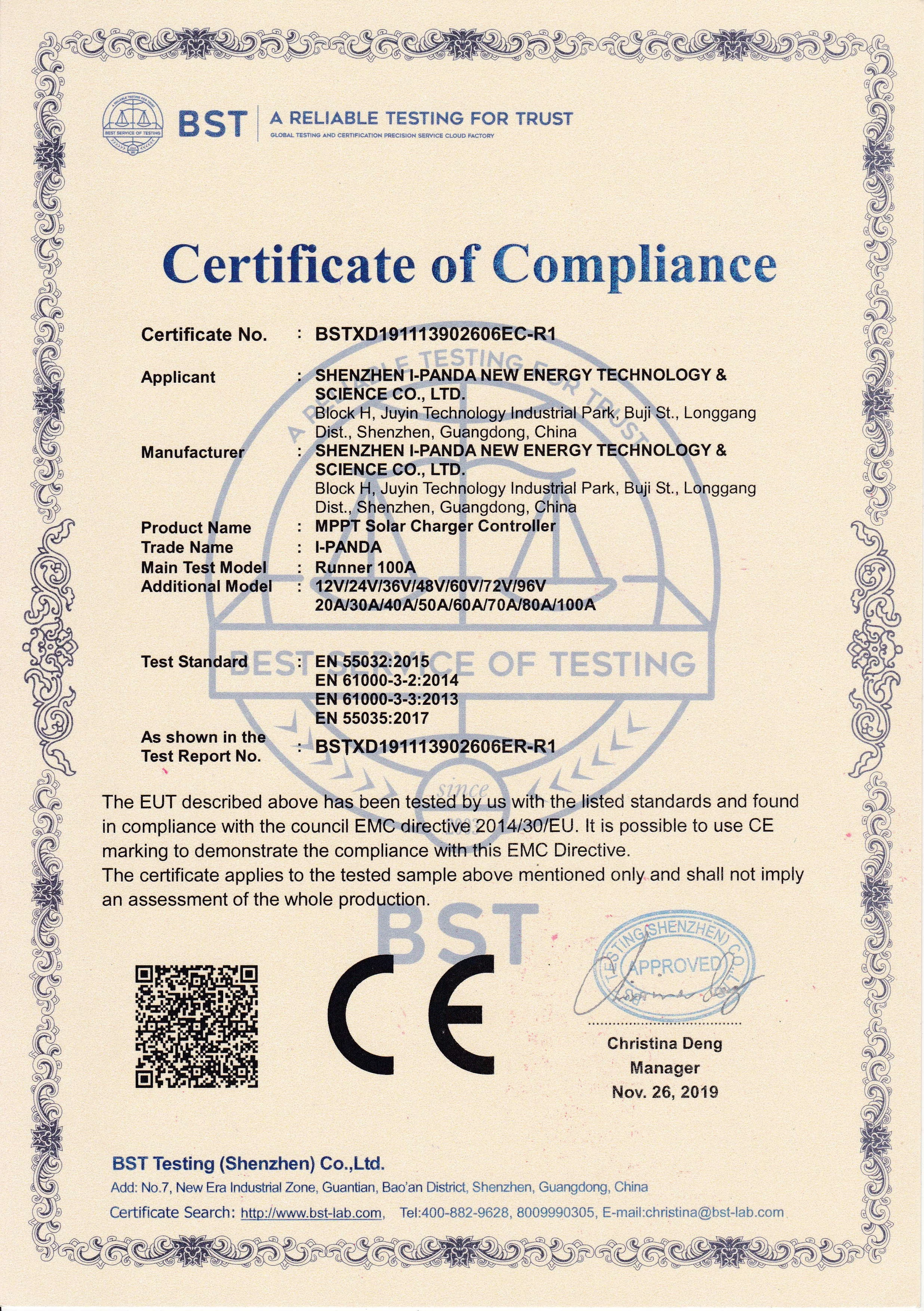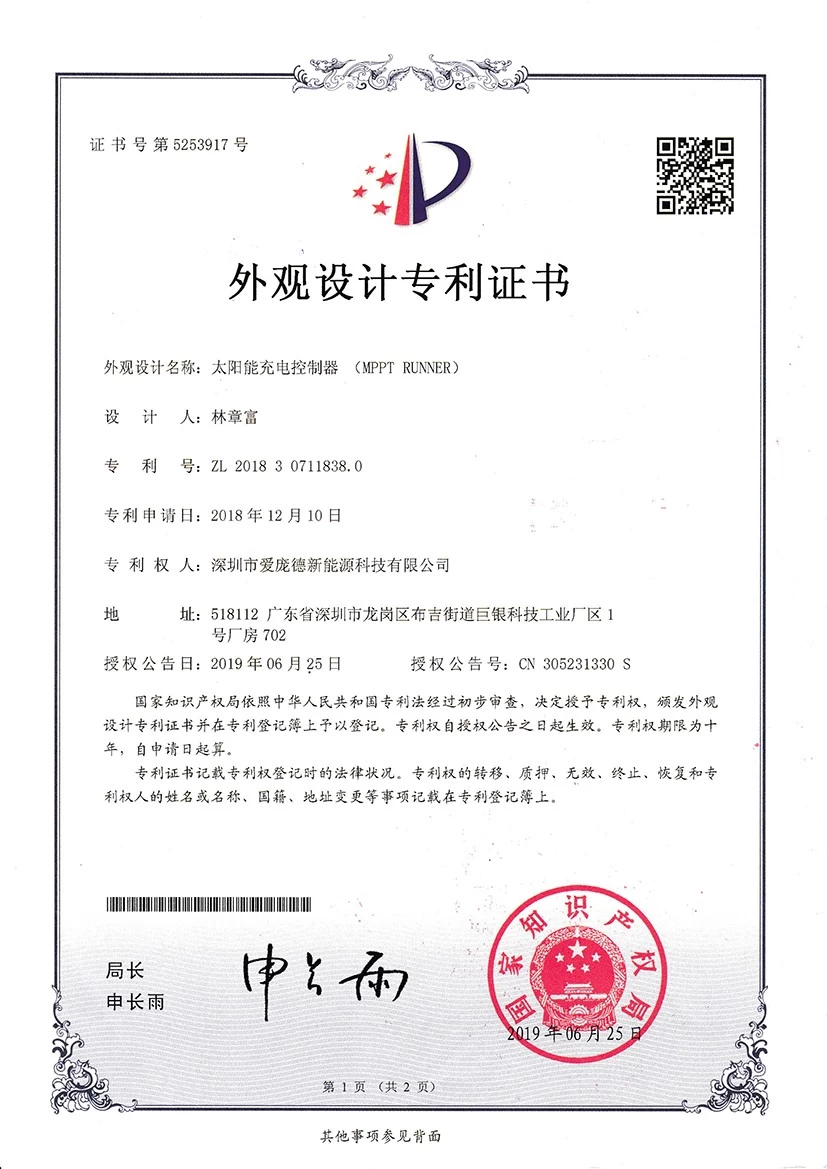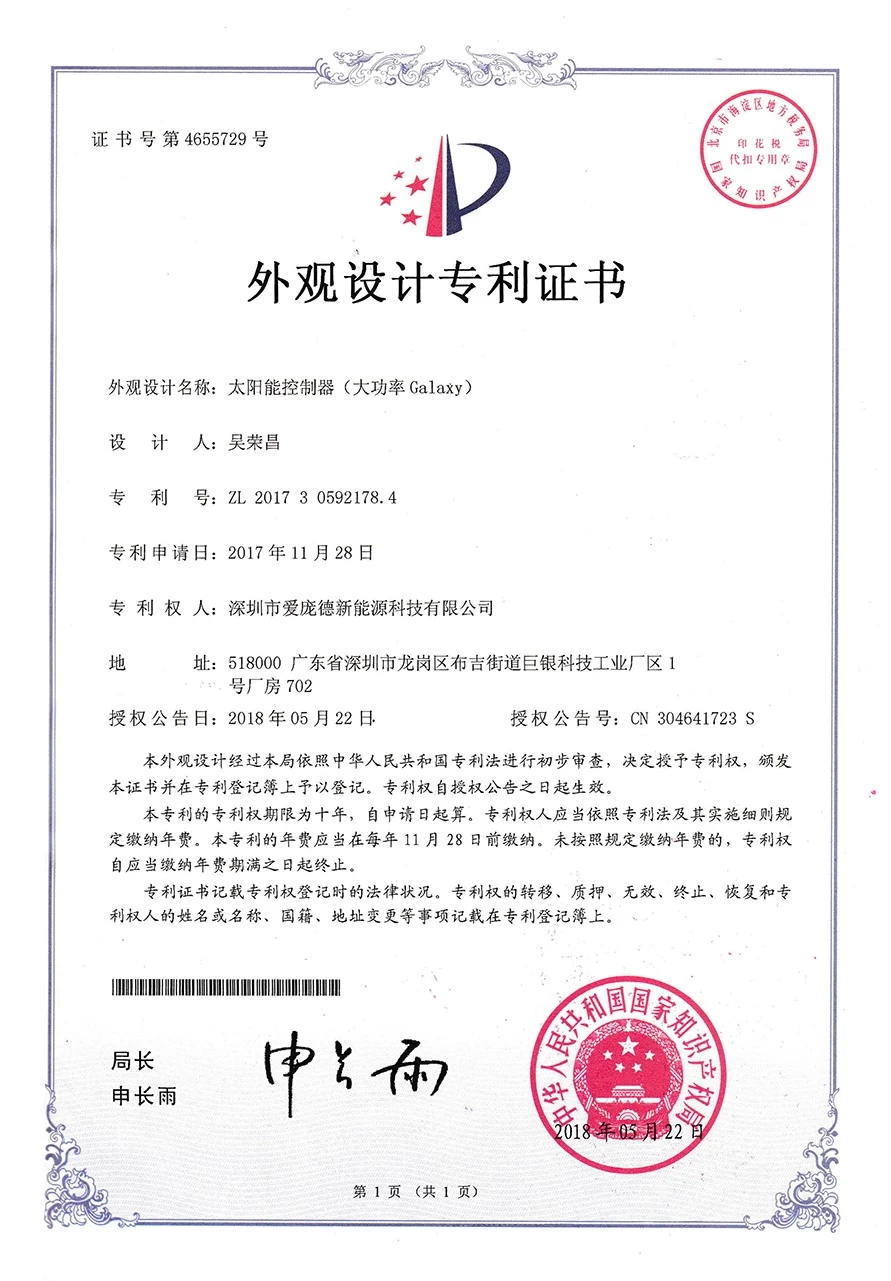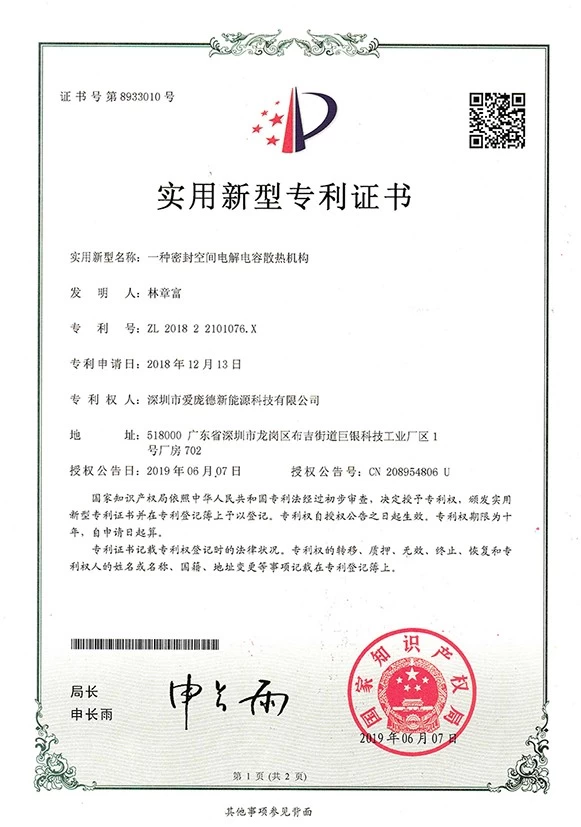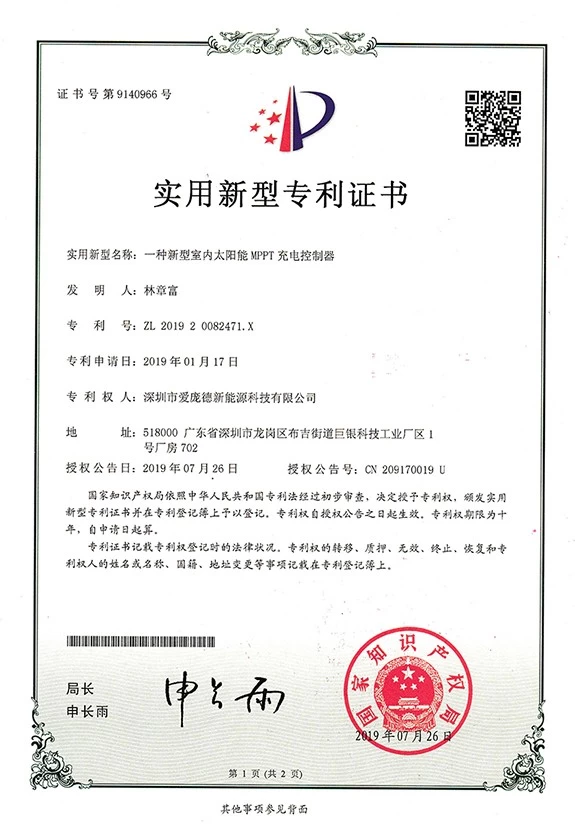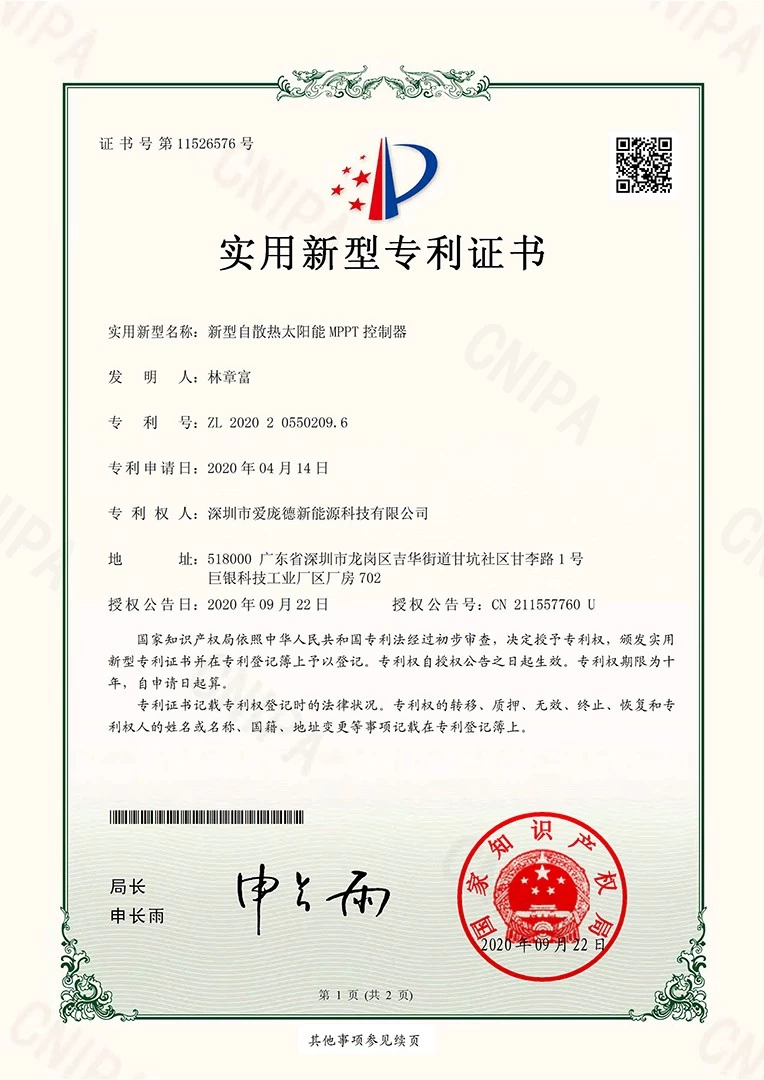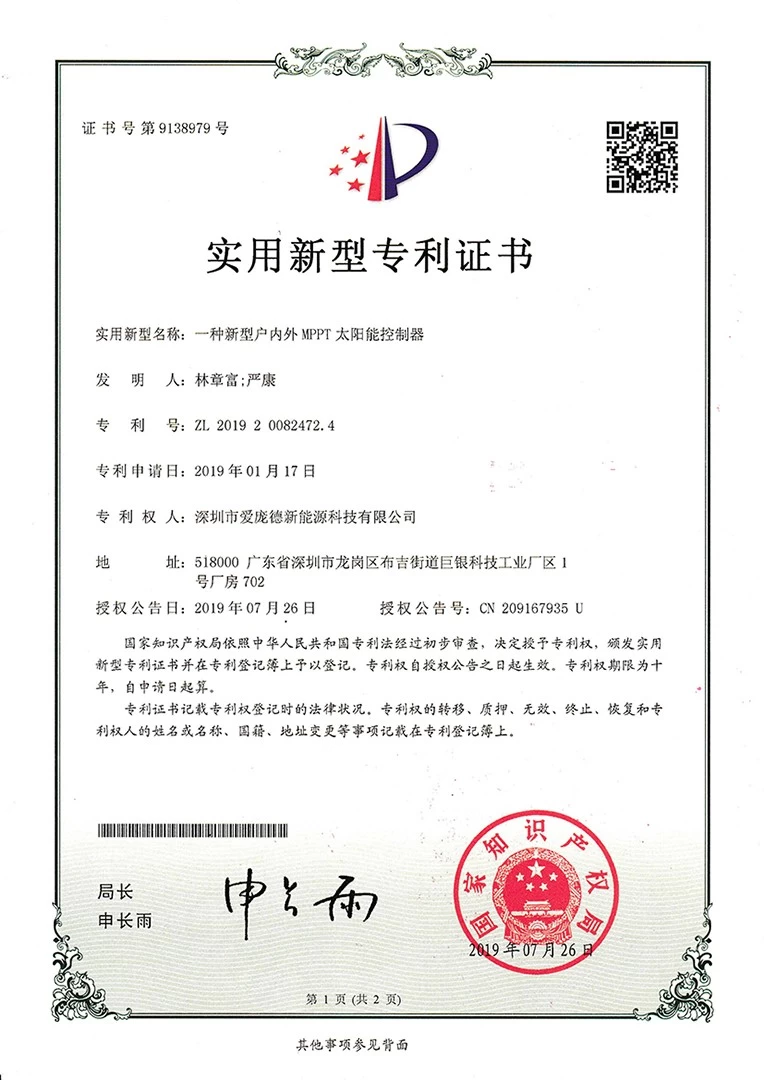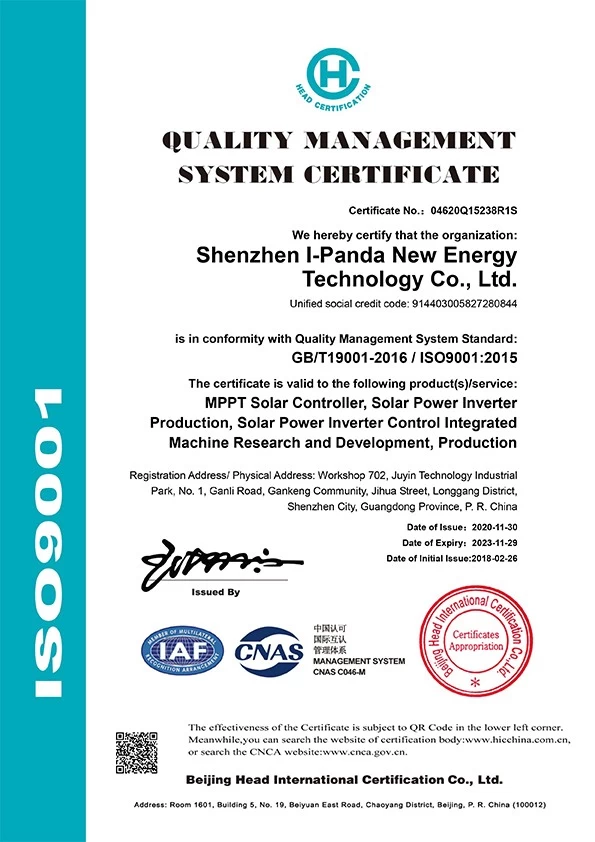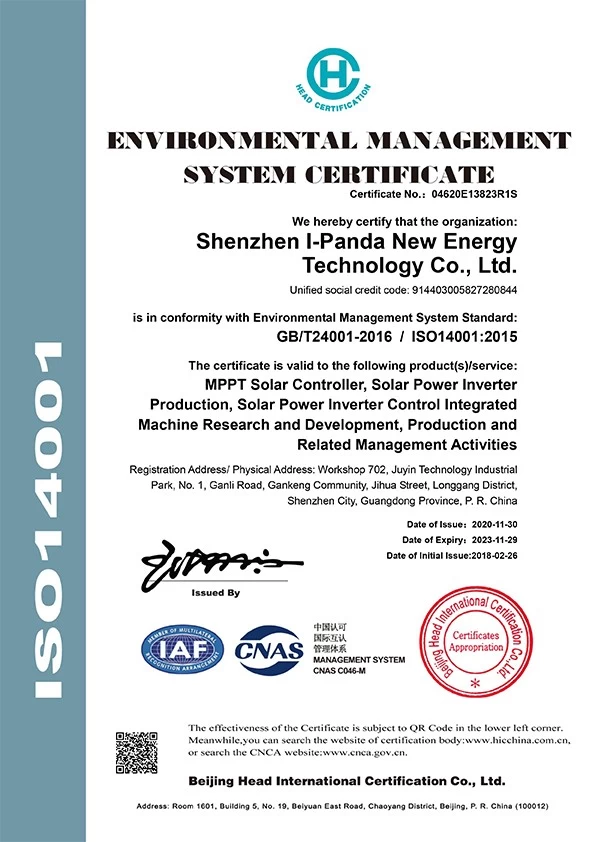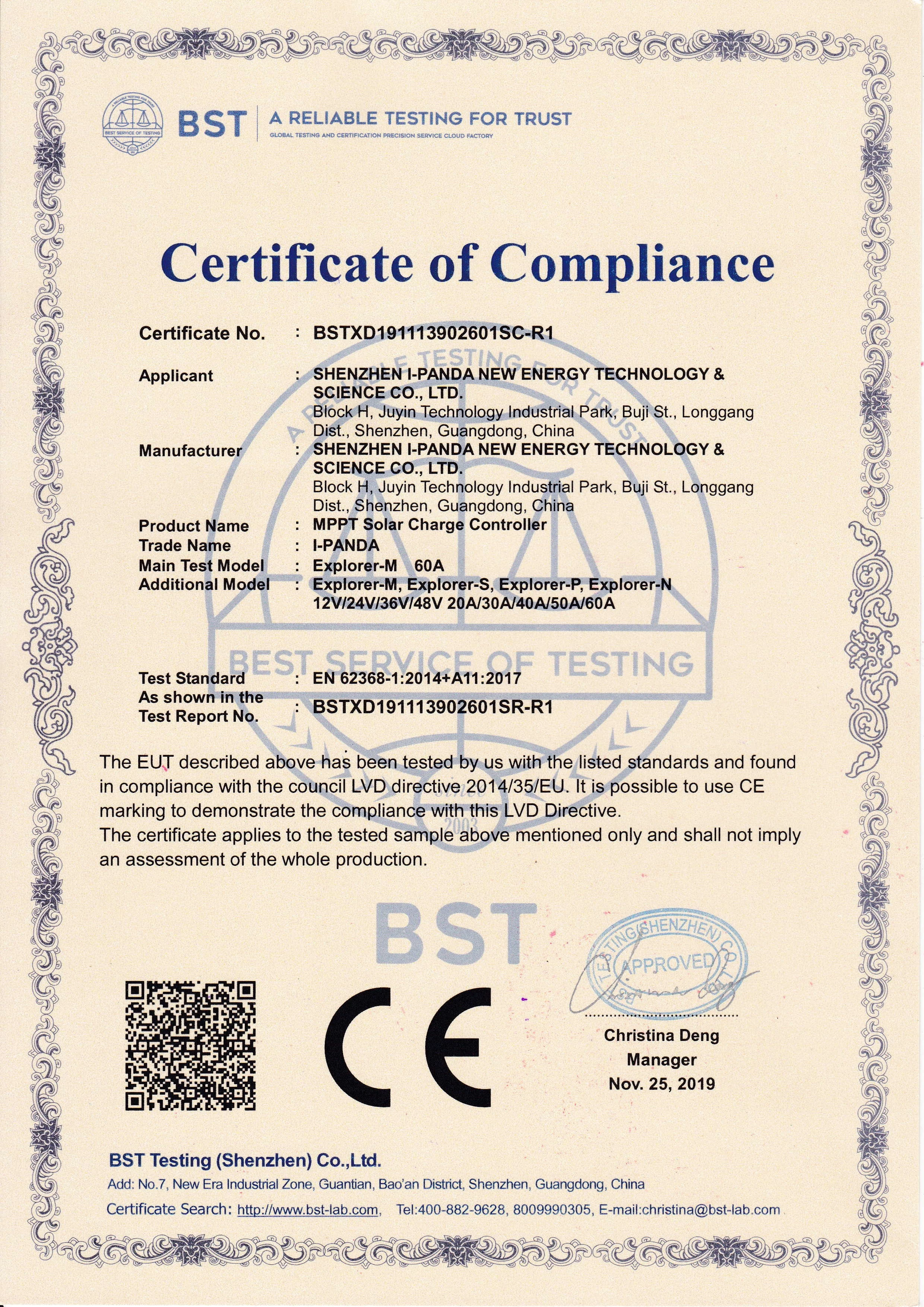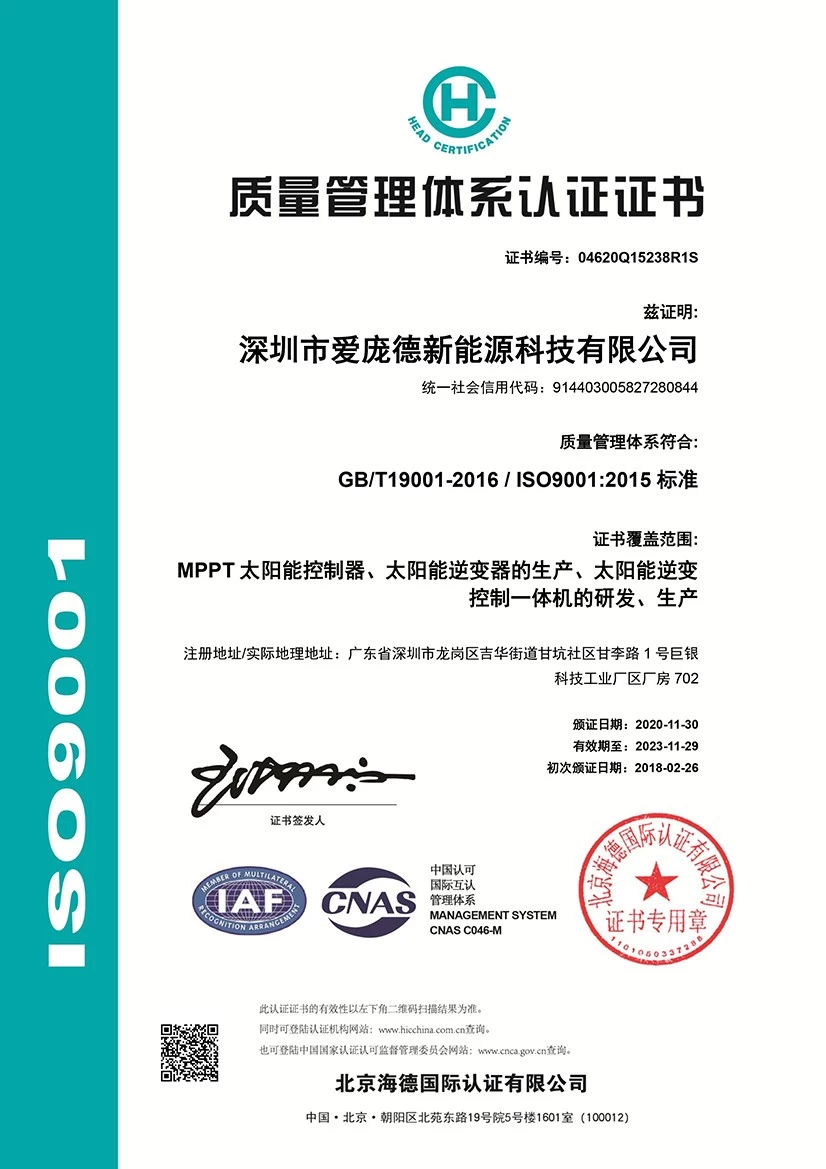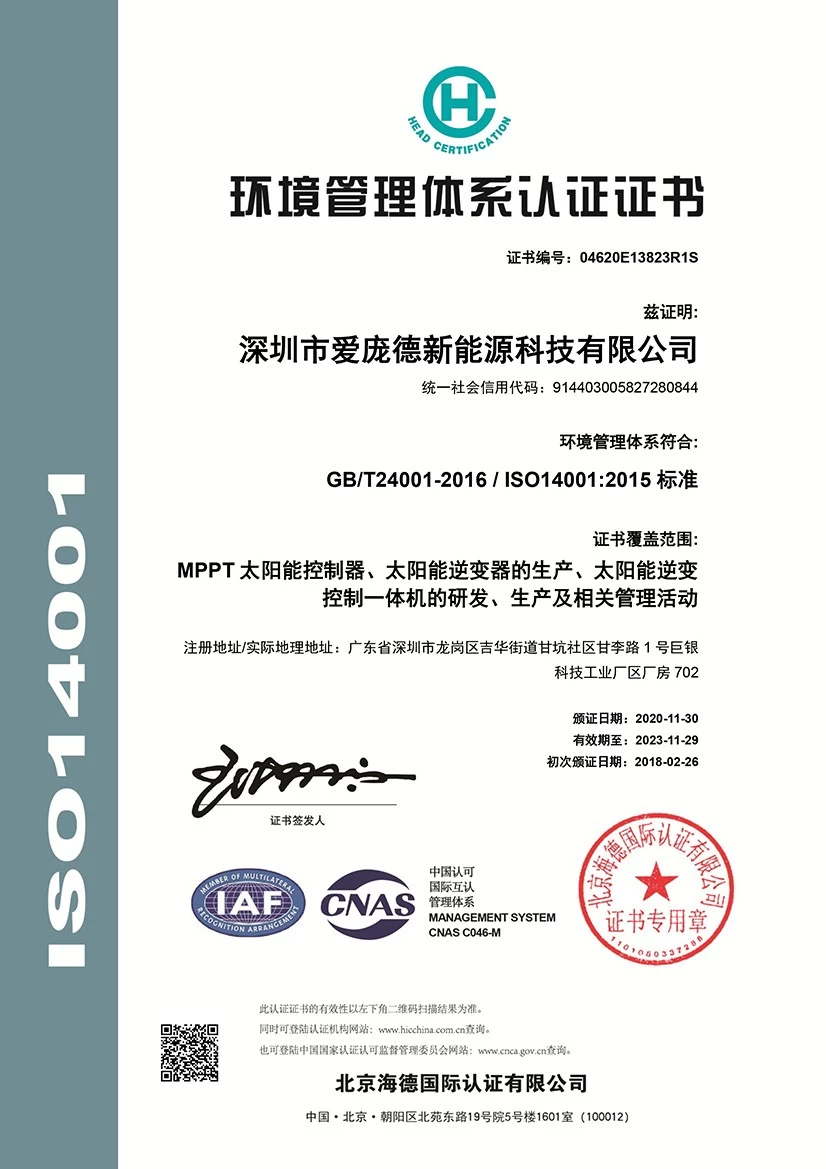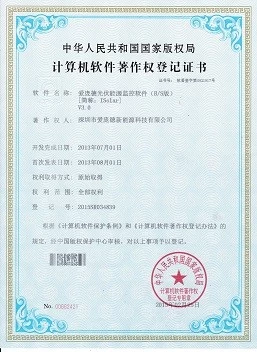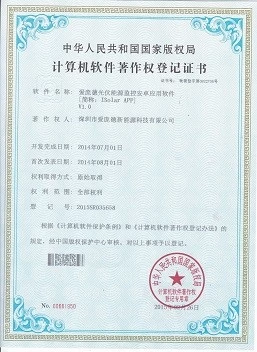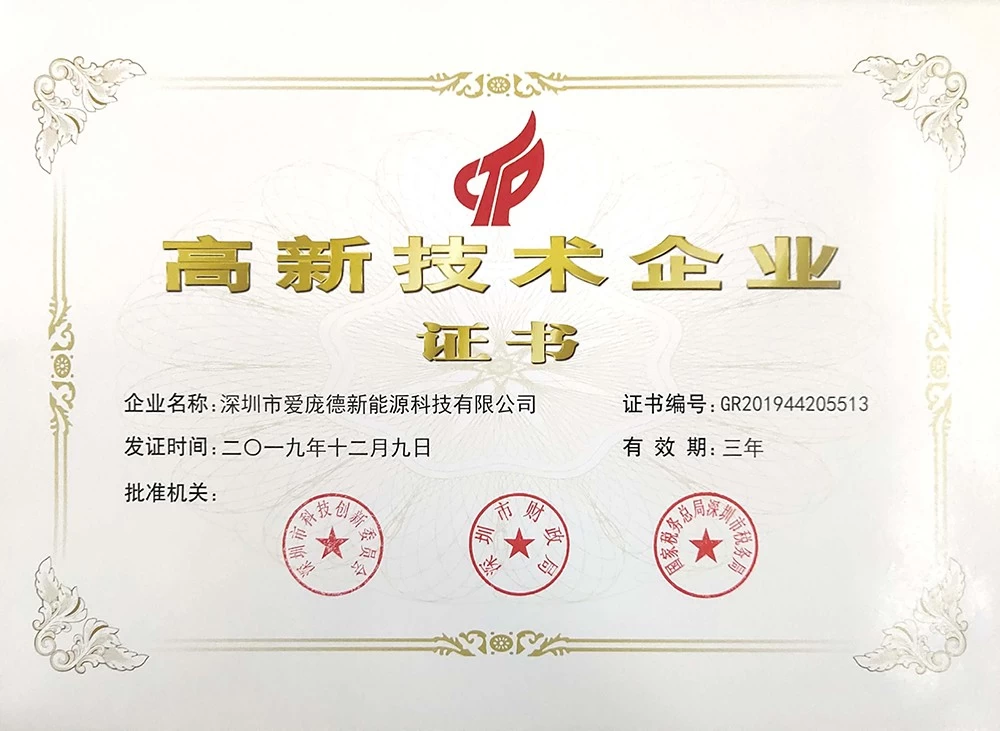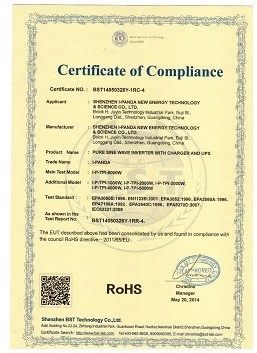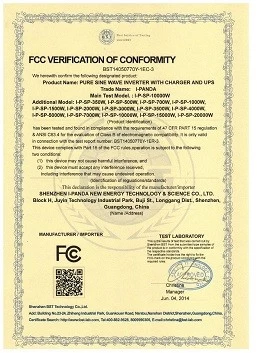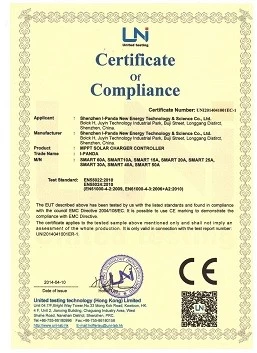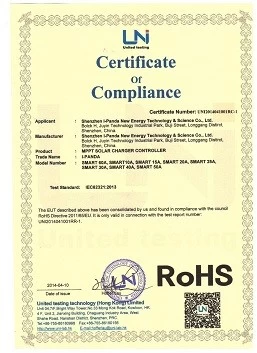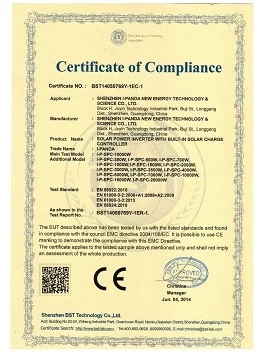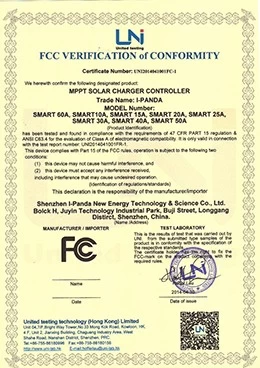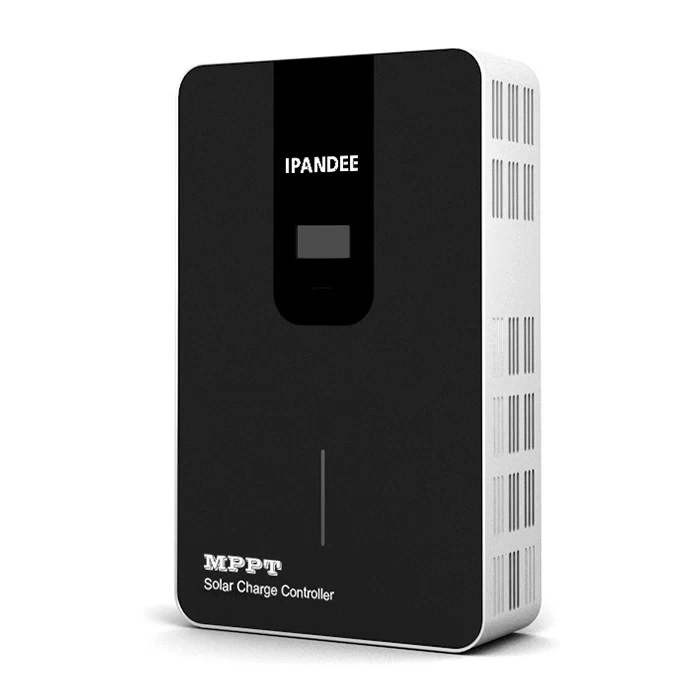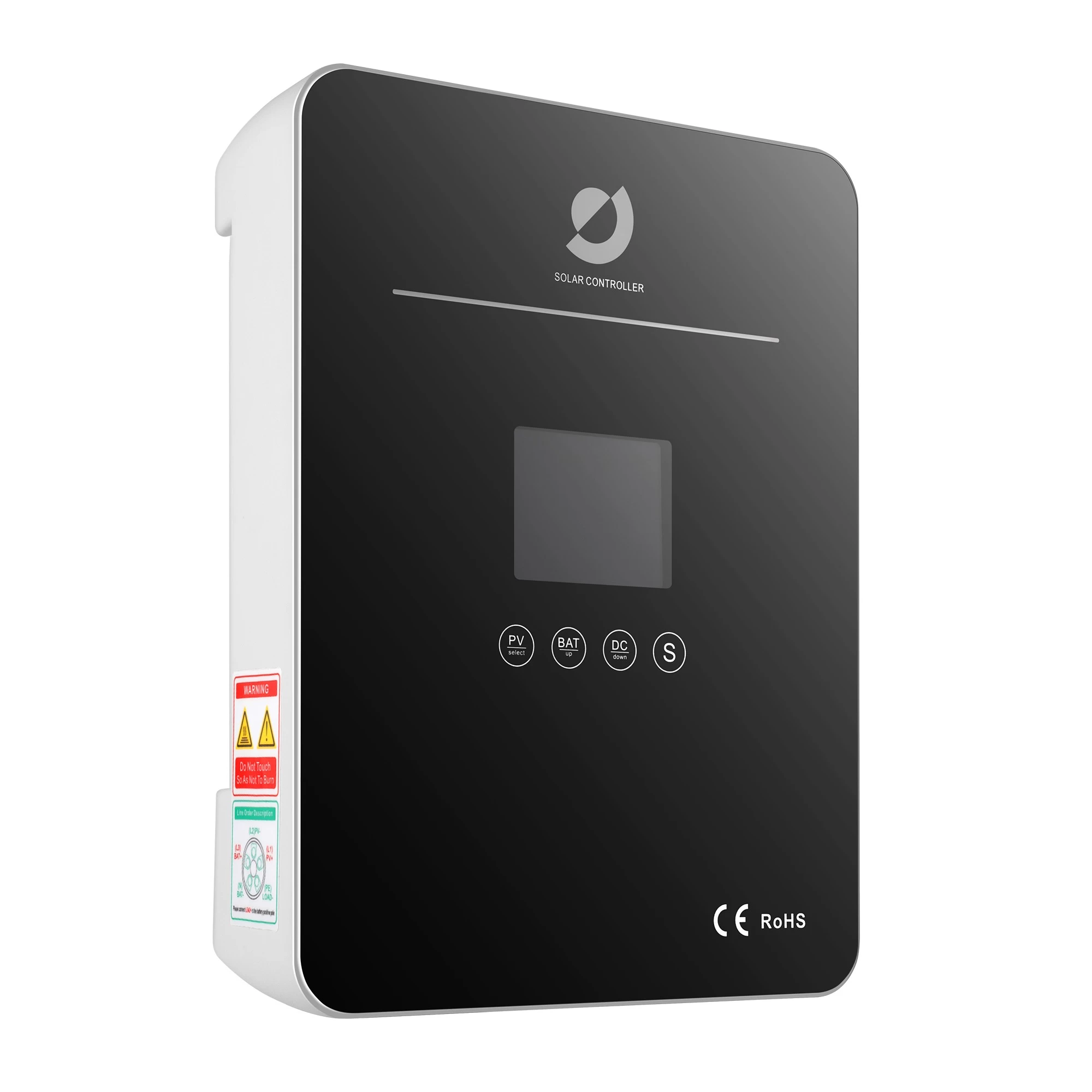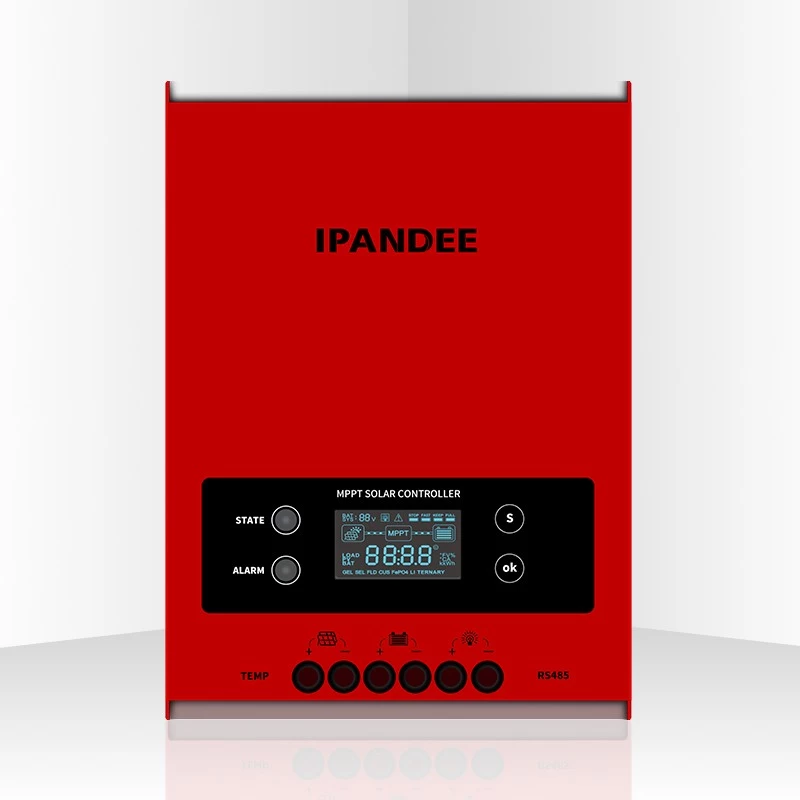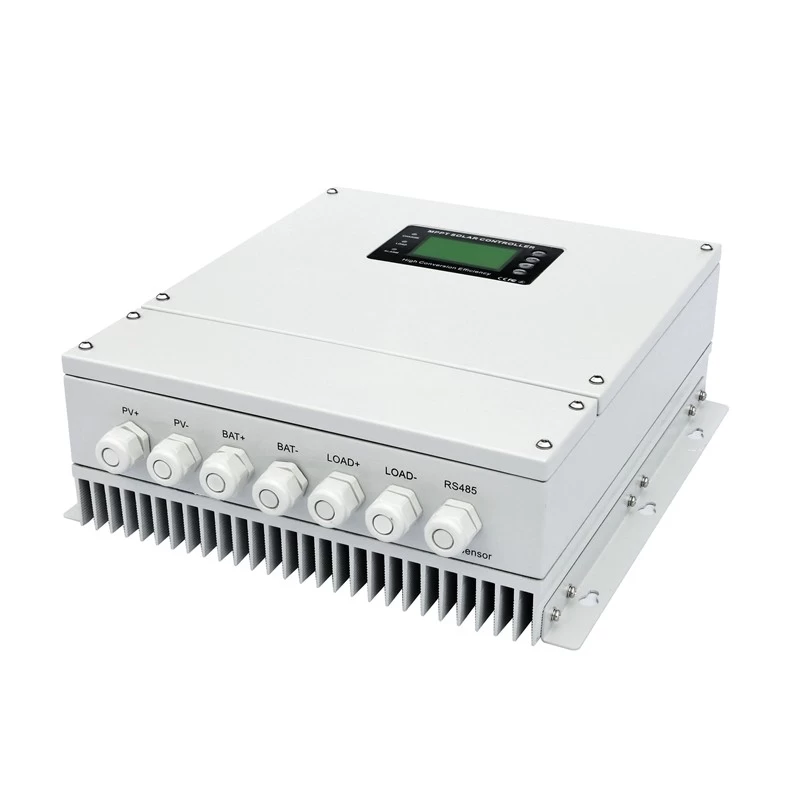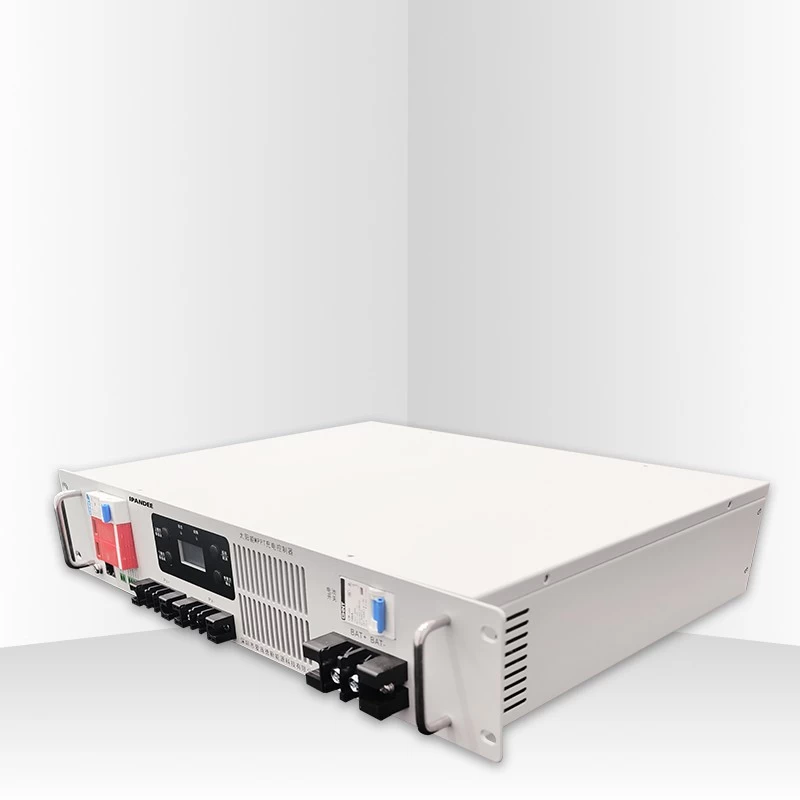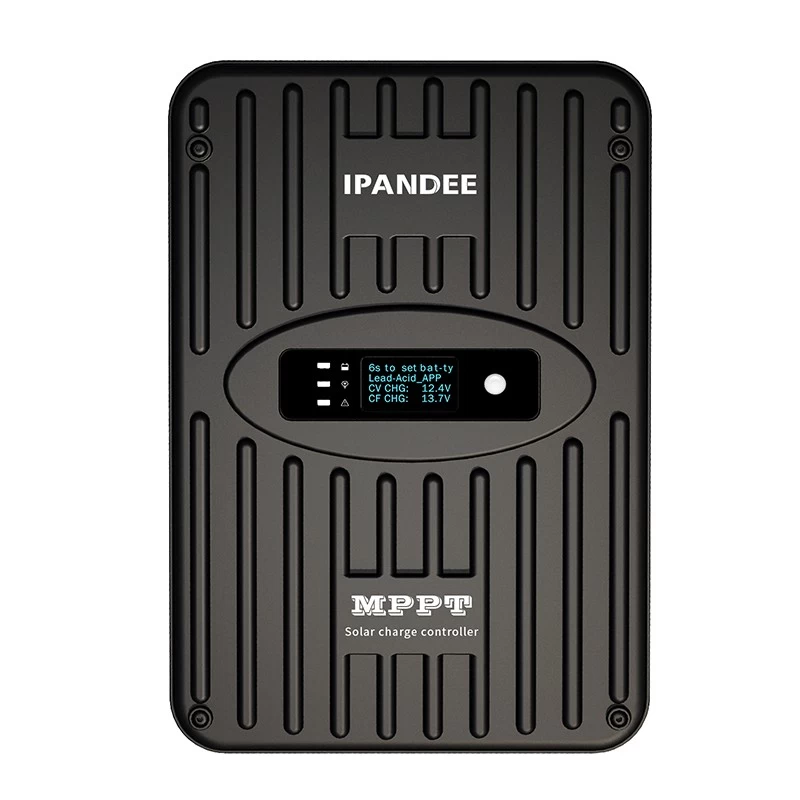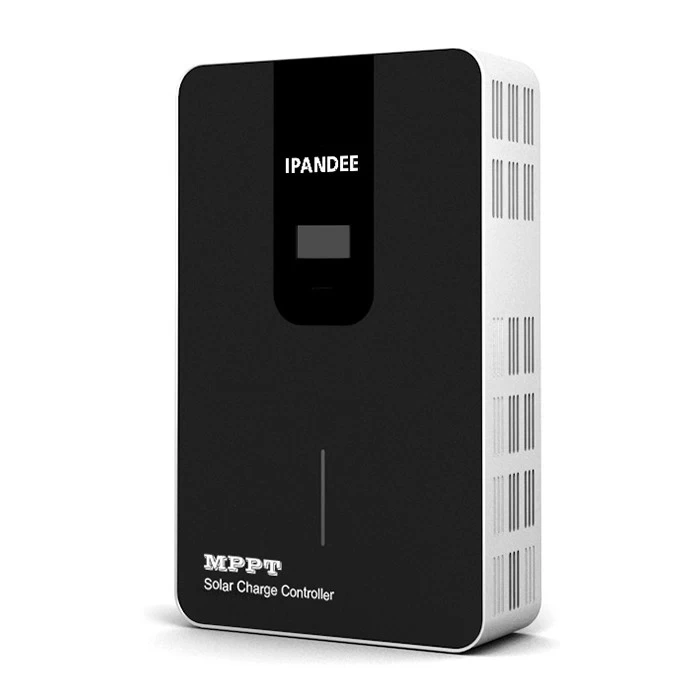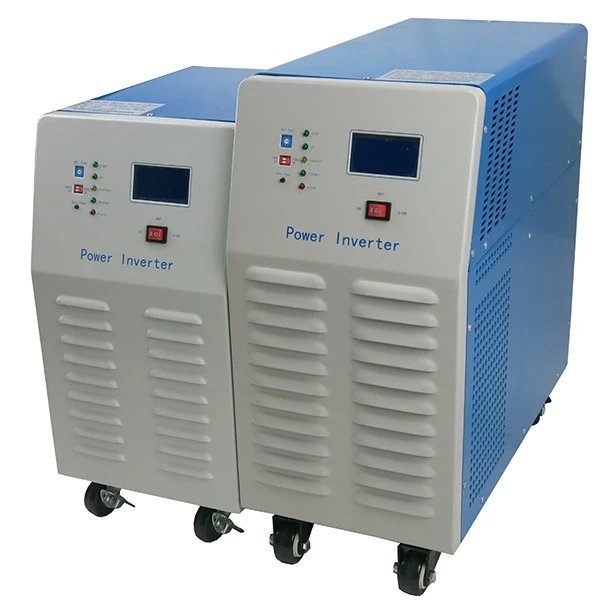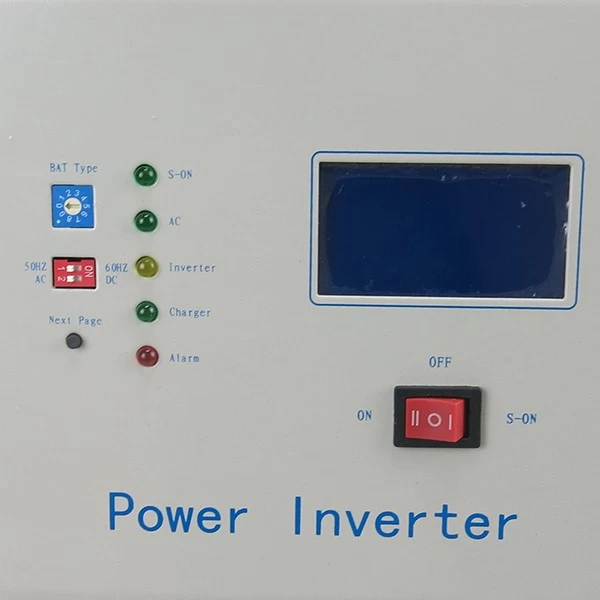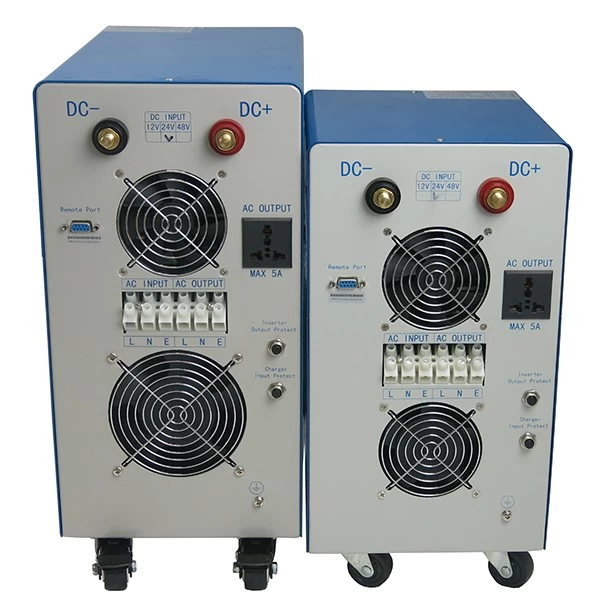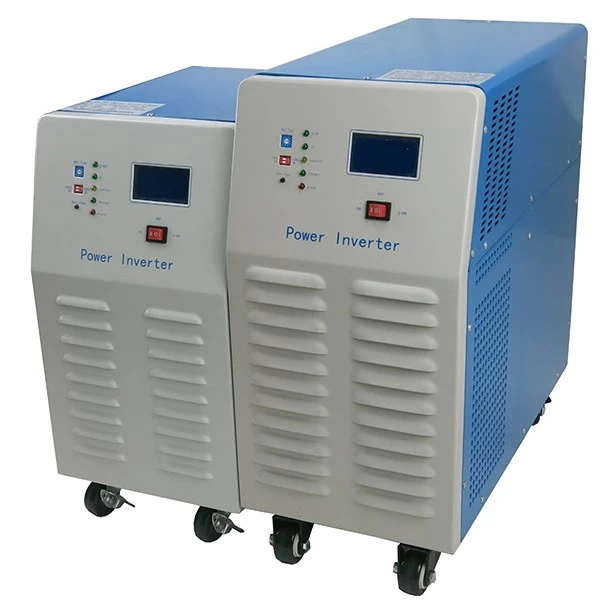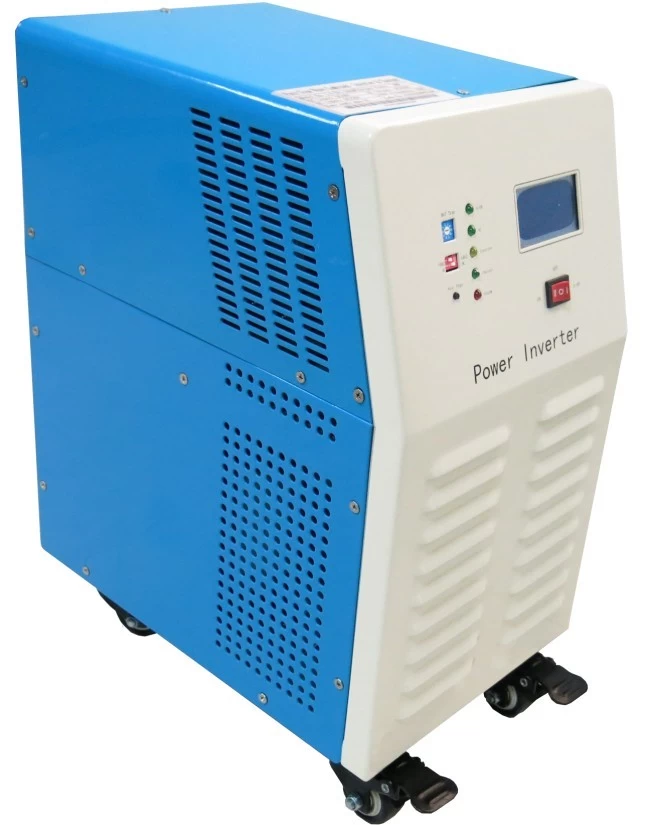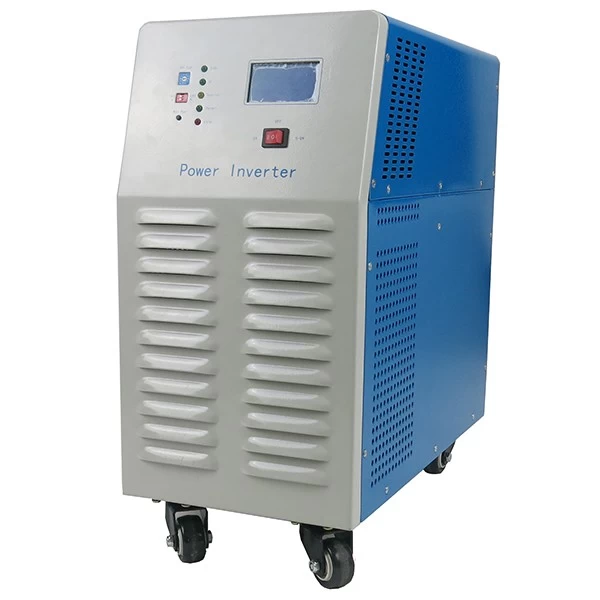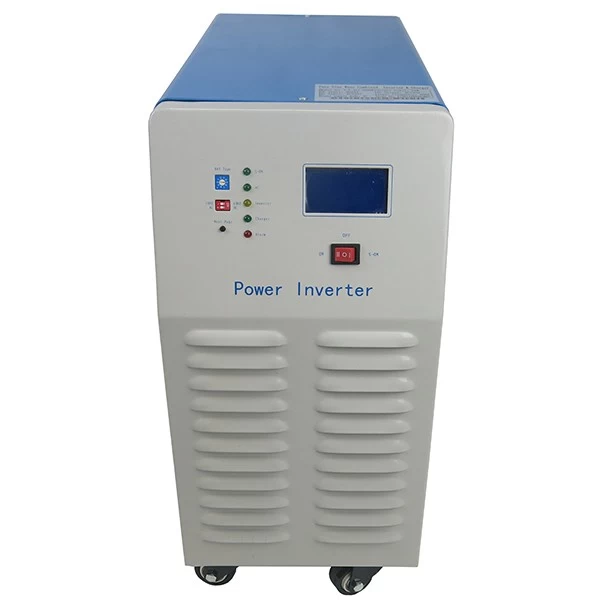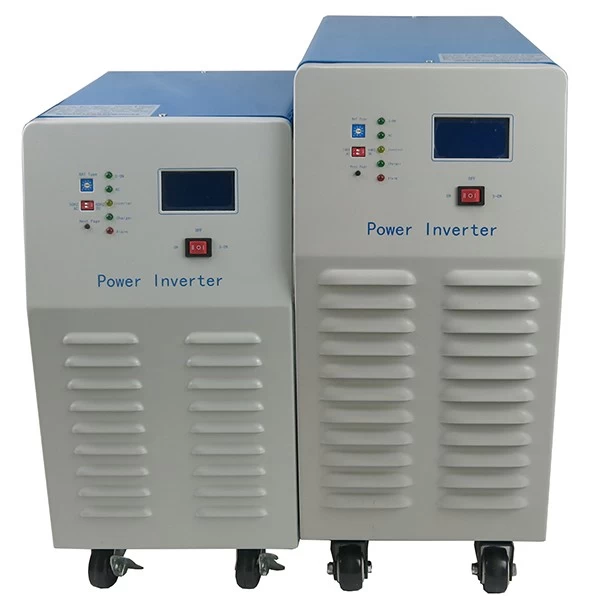- Browse Categories
- EMMPT48 series MPPT solar charge controller
- The Explorer-NS series MPPT solar charge controlle
- MPPT solar charge controller eSmart4
- EXPLORER-M MPPT Solar Smart Digital Controller
- EXPLORER MPPT Solar Smart Digital Controller
- RUNNER MPPT Solar Smart Digital Controller
- GALAXY high power series MPPT solar controller
- MARS outdoor series MPPT solar controller
- eSMART series MPPT solar controller
- MASTER series MPPT solar controller
- Accessories
- (out of product)WISER series MPPT solar controller
- (out of production)Inverter SP Series 350W-20000W
- (Has been removed)
- (out of production)I-Panda SPC Series Inverter
- Certifications
-
- Subscribe
-
Get email updates on new products
- Hot Products
- Contact Us
-
Tel: + 86-755-23091101&+86-755-23091100
Fax: + 86-755-23091102
Information: info@ipandee.com
address: Floor 2, building A2, LiLang Software Park, No. 31, Bulan Road, Nanwan street, Longgang District, Shenzhen
China Post code: 518000 Contact Now
- Follow us
- News
-
-
Why is the inverter starting voltage higher than the minimum voltage?
In the photovoltaic grid-connected inverter, one parameter is strange, that is, the inverter input starting voltage. This voltage is about 30V higher ... -
How to solve the AC inverter overvoltage problem?
just nowPhotovoltaicOn-grid power generation is becoming more and more popular, and ordinary people's homes can see PV power plants in real time. Howe... -
The difference between an improved sine wave and a pure sine wave inverter
This article describes the difference between an improved sine wave and a pure sine wave inverter. ModifiedSine Pure Wave: The most common general pur... -
The world's top ten PV inverter companies
The inverter is also called the power regulator. According to the use of the inverter in the photovoltaic power generation system, it can be divided i... -
What is the difference between MPPT function and solar inverter without MPPT function?
The MPPT controller utilizes maximum power point tracking technology to extract the maximum power from the solar array to charge the battery. The maxi... -
Why should the inverter stop working when the grid is out of power?
Some people install a photovoltaic system, they will have a mentality of "even if the power grid is cut off, if there is a sun, and their homes can us... -
Europe's first waste photovoltaic panel recycling plant
Solar panels have a service life of 20 to 30 years. Along with the mass production of the global solar energy manufacturing industry in the past few y... -
Scientists have discovered that sand can make solar cell silicon materials
According to a report by the Kyodo News Agency on November 6th, visiting professors of the University of Tokyo, Sugawara, and others opened a joint st... -
Domestic energy storage market competition pattern
Energy storage as a new market for many battery manufacturers in China andInverterVendors bring the opportunity to expand new affairs and change the p... -
Portugal will achieve 100% renewable energy supply in 2050
Portugal's Minister of Environment and Energy Transformation João Pedro Matos Fernandes revealed that Portugal will achieve its carbon neutrality tar...
-
low frequency UPS TPI2 12V 24V 48V electronic inverter
- Application
- 1. Back-up UPS and EPS system for military, industrial, commercial, household,etc
- 2. Removable standby power supply for areas that are lack of utility
- 3. Off-grid solar or wind power system
- 3.1. Off-grid solar or wind power system
- 3.2. AC first Off-grid solar or wind power system
- 3.3. DC first Off-grid solar or wind power system
- In the above application fields, this series of inverter is suitable for all kinds of inductive loads, capacitive load and resistive load such as TV, air conditioner, refrigerator and washing machine.
Introduction
I-P-TPI2-1000W-6000W is adopted the world's leading low-frequency inversion technical solutions. This series of inverter has the advantages of high conversion efficiency, low power consumption, super load-carrying ability, and large charging current. Users can set it to sleep mode and normal working mode according to the AC loads. Users also can set the output priority (AC first or DC first) and choose the output frequency 50Hz or 60Hz. It’s our second generation TPI series.
Features
1. Pure sine wave output
2. CPU management, intelligent control,modular design
3. LCD and LED display can show the parameters and inverter working status.
4. Users can set it in sleep mode or normal working mode and set output priority (AC first or DC first). The output frequency (50Hz or 60Hz) can be chosen.
5. High conversion efficiency (87%-98%), low power consumption (1W~6W under sleep mode). It is the best choice of inverters for solar power system
6. The inverter can charge 8 kinds of batteries such as sealed lead acid battery, open lead-acid battery, gel battery. Kindly note: The lithium battery can be charged also, the related parameters need to be set in factory.
7. High charging power and the charging function can be closed
8. This series of inverters have strong load-carrying ability and overload capacity. The peak power is 3 times of the rated output power. For example, 1KW model can drive 1HP air conditioner, 2KW model can drive 2HP air conditioner, 3KW can drive 3HP conditioner.
9. Adopting the latest American low frequency circuit design, brand new imported electric materials, pure copper transformer, and the system is very stable long service life (more than 5 years under normal use)
10. Perfect protection (low input voltage protection, high input voltage protection, over temperature protection, short-circuit protection, overload protection)
11. EMC、LVD、RoHS certification approvals
12. 2-year warranty and life-time technical assistance.
Function
1. DC/AC Conversion Function
It can be set to normal working mode (on the panel turn the button to “ON”) or sleep mode (on the panel turn the button to S-ON)
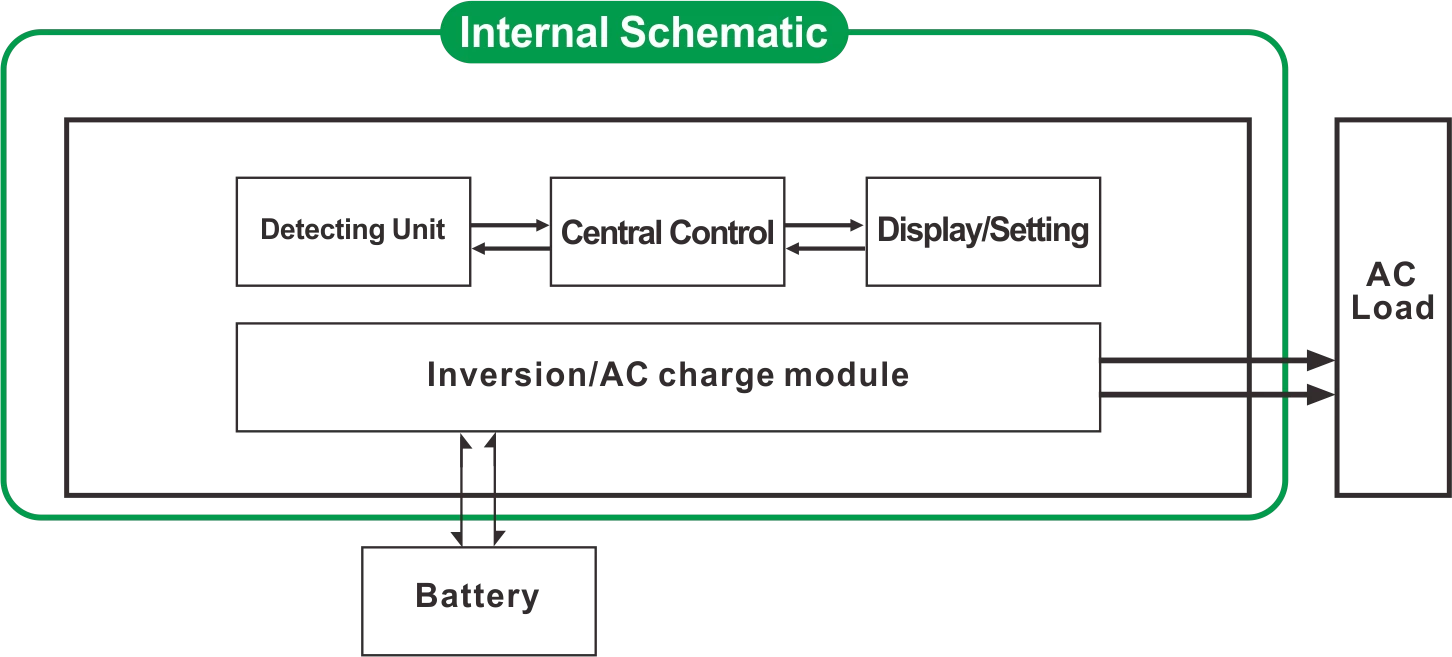
1.1 Normal working mode (ON): No matter it’s connected AC loads or not
the inverter always convert DC to AC. The LCD of the inverter displays the output voltage. The power consumption in normal working mode is a little higher than in sleep mode
1.2 Sleep mode (S-ON):If the power of the connected AC loads is lower than 5% of the rated power of the inverter, there is no output from the inverter. The LCD of it shows 0. Only the chip of inverter is working. The power consumption of the inverter is only 1-6W. If the power of the connected AC loads is more than 5%, then the inverter automatically convert DC to AC to supply power for the loads within 5s. The LCD of it displays no output.
2. High-power intelligent charging function
It Can charge 8 kinds of batteries (detail please check parameter)
High charging power (detail please check parameter)
Three-stage charging mode: Constant current charging stage (CC), Constant voltage charging stage (CV), Float charging stage (CF)

Note: When the battery type is set to “0”, it will not charge the battery and charging current is “0”. The charging indicator will not light.
3. UPS function
It can be set as utility first (AC first) battery standby mode or battery first(DC first) utility standby mode.
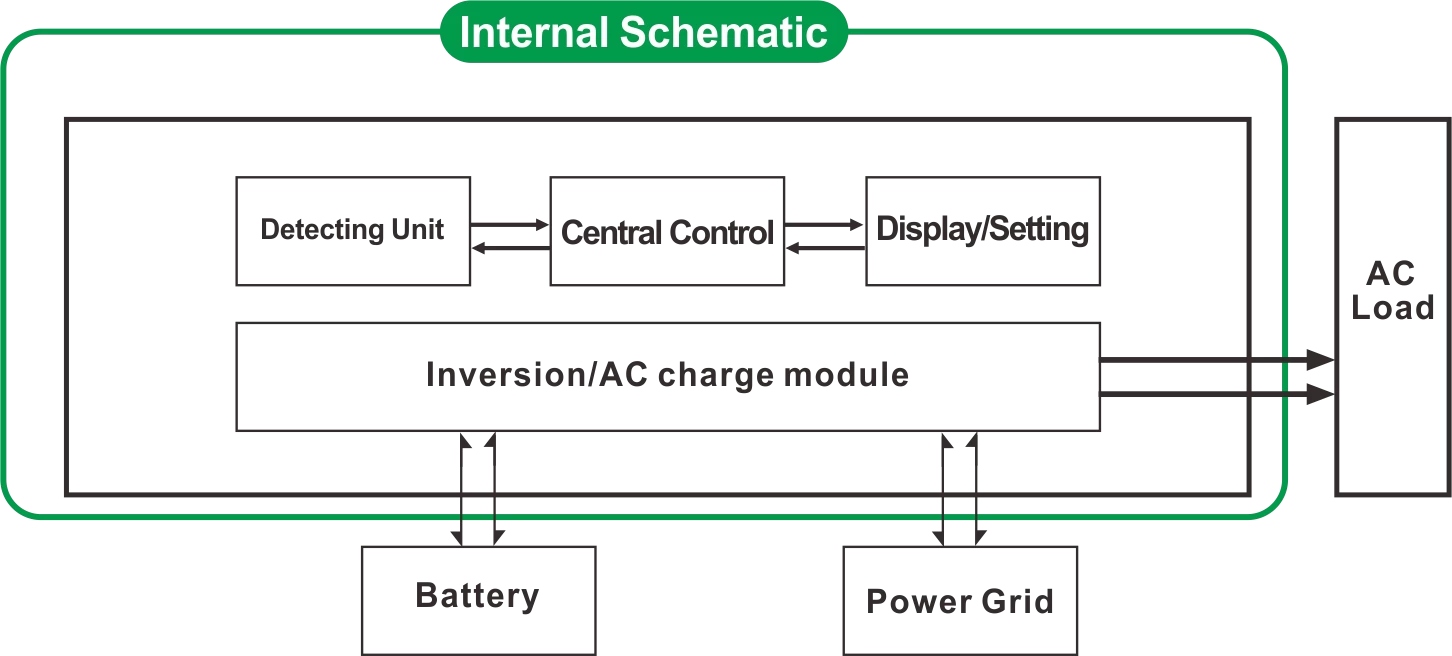
3.1. Utility first battery standby UPS mode (on the panel turn the button to “AC”)
When utility and battery are connected to the inverter, utility will supply power to the loads prior. When utility is cut off, the battery will automatically continue to supply power via power inverter.
Steps are as below:
Step 1: When utility is available, it will drive the loads directly and at the same time charge batteries.(battery type on the panel can not be 0) LCD will display AC output voltage.
Step 2: When utility power is cut off, the inverter will convert DC power (battery) to AC power automatically to ensure uninterrupted power supply within 5ms. UPS function
Step 3: When utility is available again, inverter will automatically transfer to utility supplying power to loads. And utility will charge batteries via power inverter at the same time.
See Workflow as below.
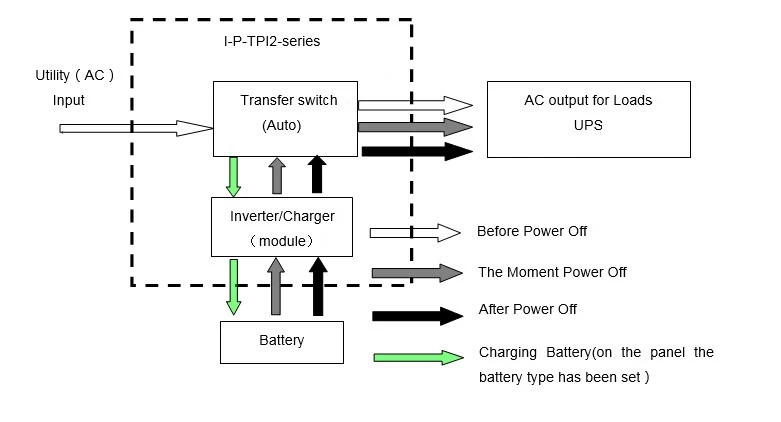
3.2. Battery first utility standby UPS mode (on the panel turn the button to “DC”).
In this mode, users need to set “battery type” to “0”on the panel. Utility will not charge the battery.
When utility and battery are connected to the inverter, battery will
supply power to the loads prior. When battery capacity is not
enough, utility will continue to supply power to the loads automatically.
Steps are as follows:
Step 1: When battery has enough power, it will supply power to the loads directly
Step 2: When battery does not have enough power, inverter will automatically transfer to utility supplying power to the loads
Step 3: After the battery is fully charged (e.g. by solar or wind charge controller), it will automatically transfer to battery supplying power to the loads via power inverter.
See Workflow as below.
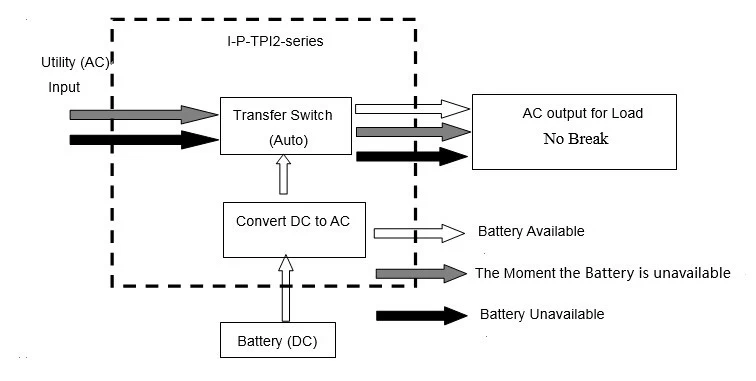
Parameter
Parameter Model 1000W 2000W 3000W 4000W 5000W 6000W Rated Output Power 1000W 2000W 3000W 4000W 5000W 6000W Peak Power 3000W 6000W 9000W 12000W 15000W 18000W Battery Voltage(DC) 12V or 24V or 48V(optional) 24V or 48V(optional) Size W×D×H(mm) 318*218*368 440*218*400 Packing Size W×D×H(mm) 395*275*520 520*275*520 Net Weight (kg) 27 28 30 39 40 51 Gross Weight (kg) 29 30 32 43 48 53 Working Mode (Setting) ON Normal working mode S-ON Sleep Mode.1-6W consumption When load’s power higher than 5% rated output power, it will start to work automatically OFF Completely off AC Input Voltage 220V±35% or 110V+35%(optional) Frequency 50HZ or 60HZ AC Output Voltage 220V±3% or 230V±3 or 240V±3% or 100V±3% Frequency Frequency is the same as utility’s frequency in utility mode. Frequency 50Hz or 60Hz(optional) in DC/AC convert mode Utility Charging AC Charge Current BAT 1000W 2000W 3000W 4000W 5000W 6000W 12V 35A 65A 75A / / / 24V 20A 35A 45A 65A 70A 75A 48V 10A 15A 30A 35A 40A 50A Battery Type American Gel Battery, Wool Battery 1, Wool Battery2, Sealed Lead Acid Battery, Europe Gel Battery, Open Lead Acid batteries, Calcium Battery, De-Acid Battery or OEM Battery Charging Mode Three-stage charging:CC, CV, CF Charging Time Decided by battery capacity and quantity Battery Protection Automatic detection,charge and discharge protection, intelligent management UPS Priority AC Utility first, battery standby DC Battery first, utility standby Display Display Mode LCD+LED Display Information Input voltage,output voltage,output frequency,battery capacity,Load condition,Status Information Output Wave Type Pure sine wave Overload Ability >120% 1 min,>130% 10s Power Consumption Sleep Mode 1~6W Normal Mode 1~3A Conversion Efficiency 87%~98% Transfer Time <5ms (AC to DC / DC to AC) Protection Overload output,short-circuit,high-voltage input, low-voltage input,overheats Environment Temperature -10℃~50℃ Humidity 10%~90% Altitude Tel:+86 15002089033 Contact Person:Andy PDF Show:PDF
or 110V±3%(optional)
(Battery type “0” means that AC charging function is closed)
(Max)
